
| 
|


Friends Newsletter No. 49
January 2013
Friends are the water that keeps the wheel turning. We are an independent voluntary group who relentlessly promote research, conservation and celebration of the Springs, Spouts, Fountains and Holy Wells of the Malvern Hills and of Great Malvern as a Spa Town.
In January 2013 we roll out the new Malvern Springs and Wells DISCOVERY TRAIL. The purpose of this is to stimulate visitor interest in the hills and its unique water sources. The trail is already on-line at www.malvernspringsandwells.com and QR Codes are just one way in which we plan to enhance the visitor experience.
Many of the springs and wells are on land that is privately owned and we are now recruiting owner participation in the Discovery Trail project. At our discretion we can supply outdoor quality QR panels (9 cm square) free of charge. We suggest mounting the codes on weatherproofed timber posts, which we can supply if necessary. As many of the springs and wells sites are heritage features, the posts will avoid damaging the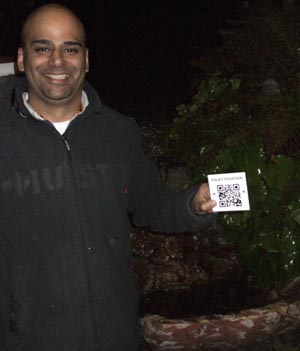 structures.
structures.
Many of the springs and wells are on land that is privately owned and we are now recruiting owner participation in the Discovery Trail project. At our discretion we can supply outdoor quality QR panels (9 cm square) free of charge. We suggest mounting the codes on weatherproofed timber posts, which we can supply if necessary. As many of the springs and wells sites are heritage features, the posts will avoid damaging the
 structures.
structures.As most will know after reading our newsletters, QR Codes provide 'on site' information and our linked web site, which gives details of over 130 individual springs and wells, is now fully operational. It is the definitive web site for such information. The data is based on 20 years of desk and field research and is continually being updated as more facts emerge. It complements the information given in our book Celebrated Springs of the Malvern Hills, of which hopefully readers have a copy.
Alongside: AJ from the Mount Pleasant Gateway to the Hills displays the Foley Fountain QR Code panel. Where a code is required for use on other material, for example on posters or in guide books, the QR Code master artwork can be downloaded free from our main web site. (Key Word Search for QR Codes)
HOT NEWS - spa archive acquired and now being sorted - more details in our next Newsletter.
Ghosts from the past or an eye for the future?
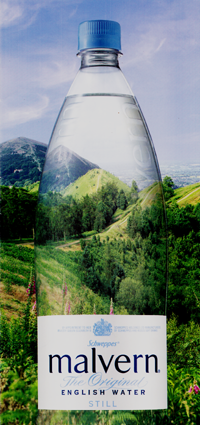 We have recently seen renewed interest in the old Bottling Works site at Colwall, as the developers endeavour to pursue a new role for the land. At this late hour, concerns are being expressed about retaining the old buildings. Are they chasing ghosts from the past rather than moving forward into the future? We hope that everyone who is orchestrating this objection to the planning submissions has considered the long term effects. We have seen this all before with the Colwall bottling works. People have got up and shouted objections and years later we see the disastrous results of their actions. Whilst it is right to preserve valuable heritage buildings, the work that Cora did in getting the Tank House listed indicated that there was little else on the site that would get similar protection. The initial English Heritage report proposed no listings despite many hours having been spent with the officer. Renewed time and effort did eventually pay off with the listing of the Tank House, following further detailed submissions.
We have recently seen renewed interest in the old Bottling Works site at Colwall, as the developers endeavour to pursue a new role for the land. At this late hour, concerns are being expressed about retaining the old buildings. Are they chasing ghosts from the past rather than moving forward into the future? We hope that everyone who is orchestrating this objection to the planning submissions has considered the long term effects. We have seen this all before with the Colwall bottling works. People have got up and shouted objections and years later we see the disastrous results of their actions. Whilst it is right to preserve valuable heritage buildings, the work that Cora did in getting the Tank House listed indicated that there was little else on the site that would get similar protection. The initial English Heritage report proposed no listings despite many hours having been spent with the officer. Renewed time and effort did eventually pay off with the listing of the Tank House, following further detailed submissions. What therefore are the likely outcomes of this latest 13th hour debate - delays or even the developers pulling out completely? Is this what Colwall wants? The site could end up as a long term derelict wasteland, when eventually in 10 years time residents will agree to anything to get the site back into a managed and useful state? If there is heritage to protect then our dialogue with the developers has always been positive to such considerations that enhance their proposals. But if I were them I would be wary of long term delays and issues that threaten the overall financial viability of their scheme.
Why are people suddenly jumping up and down now? Much earlier there was an open forum for debate with the developers. Does it give the objectors renewed credibility and public admiration rather than serve a constructive purpose? An organisation is prepared to invest in Colwall; let's support them rather than thwart their intentions. These are personal views and we accept that many will disagree - that's all part of the debate.
Why are people suddenly jumping up and down now? Much earlier there was an open forum for debate with the developers. Does it give the objectors renewed credibility and public admiration rather than serve a constructive purpose? An organisation is prepared to invest in Colwall; let's support them rather than thwart their intentions. These are personal views and we accept that many will disagree - that's all part of the debate.
December was extreme with its rain and flooding - is our climate deteriorating?
Did you know that Malvern had a Meteorological Station in the 1930s? And guess who the principal meteorological observer was? It was the renowned town surveyor of the time William Osborne Thorpe. We usually present his credentials in connection with Osborne’s Fountain, but the Malvern Gazette of Jan 13th 1934 gives a different perspective.
Here he comments on the records collected over the previous 40 years for Malvern’s weather, and compares recent events. December 1933 set up a record with less that half an inch of rain and November and December combined set a record for the two driest consecutive months since 1896. December also went on record as one of the coldest months, 'a record unlikely to be broken this century'.
It just goes to show that extremes of weather are not new and in spite of supposed global climate change, there have always been fluctuations in the weather pattern. Being the town’s surveyor, Osborn played an important role in ensuring that climatic fluctuations did not result in a water supply deficit and what today we would call a hosepipe ban.
Has Malvern Well Decorating got a Competitor?
We read in the Gazette of 21 Dec. a new development in decorating that could possibly compete with the 20 year old tradition of annual Well Decorating in The Malverns. In West Malvern they are initiating a seasonal gas lamp decorating, following the restoration and technological enhancement of the 104 heritage lanterns. With more than 130 springs and wells, well decorating can steal a lead in sheer numbers but is this the end of the story? A Friend has proposed that each gas lamp is named after a spring or well thereby bringing unison between the factions. What a good idea, that way each would have a character of its own and be identifiable by name rather than grid reference number.
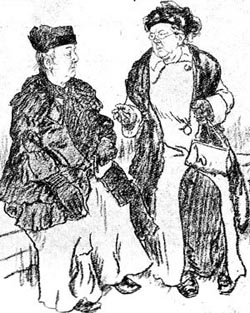
Well Gossip
Two elderly ladies were overheard chatting while relaxing near the spout on Belle Vue Terrace recently. One was enquiring of the other how things were going at home now that her grumpy old husband had retired. Raising her eyes to heaven, the reply was that life was not without problems. "Oh dear" was the response followed by a question as to what problems. The second lady said that she had sent her husband down to the spout for water for a nice cup of tea earlier in the week. While bending down he had suffered a heart attack and was pronounced dead on arrival at the hospital. "That's terrible," said the first lady, "how on earth did you cope with such a disaster, it must have been awful?"
"I went to Waitrose and bought a bottle of water!"
BOOK REVIEW - Roger Rolls (2012) Diseased, Douched and Doctored. London Publishing Partnership ISBN 978-1-907994-09-8 Available from the publishers at £9.99.
This is a thought-provoking book that solicits the question: is this the record of the demise of a branch of medicine that was once held in great esteem?
The essence of a good book is that it produces new observations and findings rather than just regurgitates the writings of others. Achieving this entails original research using archive documents, field work, archaeology, etc. Roger Rolls' new book achieves this and thus extends the scope of our understanding of the application of thermal waters for health, particularly at Britain's unique thermal spa, Bath. 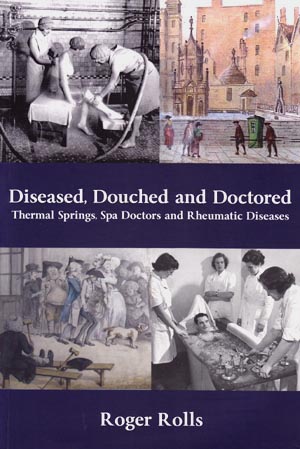 The book is fully referenced and indexed and contains 245 printed pages with soft covers. The size is 16.4 cms. x 24.5 cms. It is profusely illustrated, with many pictures in full colour.
The book is fully referenced and indexed and contains 245 printed pages with soft covers. The size is 16.4 cms. x 24.5 cms. It is profusely illustrated, with many pictures in full colour.
 The book is fully referenced and indexed and contains 245 printed pages with soft covers. The size is 16.4 cms. x 24.5 cms. It is profusely illustrated, with many pictures in full colour.
The book is fully referenced and indexed and contains 245 printed pages with soft covers. The size is 16.4 cms. x 24.5 cms. It is profusely illustrated, with many pictures in full colour.Dr. Roger Rolls, as a medical historian, was particularly active during the 1990s with the British Spas Federation, promoting well-being through the application of spa waters. This era was decisive for the spa industry, laying the foundation for the 21st century spa revival in the UK. Today we can see how the industry has evolved and Roger Rolls leaves the reader thinking that an opportunity has been missed.
Diseased, Douched and Doctors traces the utilisation of thermal spring waters for healing since the Romans, concentrating on the 17th to 19th century period when spas as a branch of medicine were in their heyday. It focuses on the waters of Bath, which are unique in the UK. It also touches on the tepid waters of Buxton, Matlock and Bristol. Detailed examples are given of the wide variety of treatments on offer over the centuries and their effects. This is of special interest to anyone wishing to investigate the former merits of spa treatments in medicine and also the problems, such as contamination of communal bathing waters by the sick. Of particular interest are the historic pictures of people showing physical symptoms such as limp limbs and swollen joints.
The changing fashion for different treatments is apparent, particularly as new technologies become available such as electricity. The case is cited of the pioneering use of electricity for healing at Worcester Cathedral in the 18th century. 'Perhaps it was the ethereal quality of electricity which rendered it attractive to ministers of religion'. (page 47) Such practices were readily integrated into the range of treatments available for 'the cure' at Bath's healing water establishments.
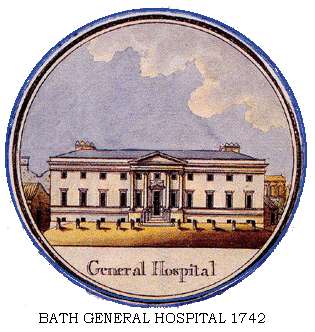
When reading the book and comparing England with European spas where medical treatments are still practiced, one can not help wondering if we have missed an opportunity for mineral water cure development, especially as it is less invasive than drugs or less irreversible than the knife. In England the sun is setting on spa waters as a serious branch of orthodox medicine. Even the Thermae Bath Spa, opened in 2006, concentrates on leisure and pleasure experiences, leaving the cure to mainstream medicine via the National Health Service.
For anyone interested in the history of medicine or the use of source waters, this book is a must that will extend their understanding of the history and development of a branch of medicine that has all but disappeared in England.
Comment - Today we still see new concepts emerging in the use of natural waters such as water with a memory. Do these genuinely open new doors for the industry or is it a desperate attempt to stay afloat on a sinking ship? Perhaps Malvern Spa has found the answer. As a result of initiatives taken by a small number of people in the early 1990s, Malvern springs and wells are now an internationally recognised tourism attraction, ironically purveying health to the visitors as they exercise by walking the famous hills in search of the many water features on the Discovery Trail.
A full review is available on our web site - key word search for Book Reviews.
DIGGING A WELL - HOW DO THEY DO IT?
Most 19th and early 20th century houses in Malvern have their own well: it was cheaper for builders to dig a well for mixing mortar then pay for metered water, and the householder then had a permanent free supply. It's rare for us to stop and think about how these wells were made. Cora asked former well digger Tony Hughes about the family business.
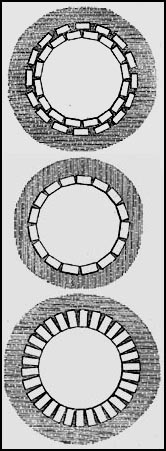 Well sinking was a two man job. In the 1940s Bertram Hughes and Arthur Quinney used to dig two types of wells in the Black Country: brick-lined and concrete-cylinder lined. To make a brick-lined well, one of them would dig down five to six feet with a four foot diameter. Then a steel ring in three parts, bolted together, and secured by three chains from a tripod at the head of the well, would be loaded with several rows of bricks, one row on top of another. This was all then lowered to the bottom and more bricks laid on top of the rows until the bricks reached the surface. Then one of the men would start digging again, underneath the circle of bricks. As the digging progressed, the man at the top would keep on adding more rows of bricks. After another five feet, using the chains, he lowered the brick tube down to the next level. This process went on until the well was sunk to below the spring. The idea was to have the well dead-centre over the spring with water coming in on one side and exiting on the other. When the required depth was reached the steel ring was removed and the circular ring of bricks rested on the well floor. Sand was back-filled between the bricks and the wall of the well. The external pressures caused the bricks to press into each other, forming a circular keystone effect, the same as you see in the arches of a church door or window with the top centre stone as the key stone. (see illustration) On one or two jobs in Worcestershire where they were digging through sandstone and the well was less than thirty feet deep, they dug straight down and then lined the well after, as there was no danger of the sides caving in.
Well sinking was a two man job. In the 1940s Bertram Hughes and Arthur Quinney used to dig two types of wells in the Black Country: brick-lined and concrete-cylinder lined. To make a brick-lined well, one of them would dig down five to six feet with a four foot diameter. Then a steel ring in three parts, bolted together, and secured by three chains from a tripod at the head of the well, would be loaded with several rows of bricks, one row on top of another. This was all then lowered to the bottom and more bricks laid on top of the rows until the bricks reached the surface. Then one of the men would start digging again, underneath the circle of bricks. As the digging progressed, the man at the top would keep on adding more rows of bricks. After another five feet, using the chains, he lowered the brick tube down to the next level. This process went on until the well was sunk to below the spring. The idea was to have the well dead-centre over the spring with water coming in on one side and exiting on the other. When the required depth was reached the steel ring was removed and the circular ring of bricks rested on the well floor. Sand was back-filled between the bricks and the wall of the well. The external pressures caused the bricks to press into each other, forming a circular keystone effect, the same as you see in the arches of a church door or window with the top centre stone as the key stone. (see illustration) On one or two jobs in Worcestershire where they were digging through sandstone and the well was less than thirty feet deep, they dug straight down and then lined the well after, as there was no danger of the sides caving in. The job was just the same with the concrete-lined wells: dig down five or six feet, drop the first concrete cylinder down using a crane, then dig down the same depth again. As the soil was taken from under the cylinder it would drop a few inches at a time; then the next cylinder would be placed on top and they would slide down slowly as the well went down, until they reached the spring at the bottom of the well. Below the water line the well was lined with bricks because bricks would not contaminate the water but at the same time would let the water through. The top of the well was made so that the well water could not be contaminated by surface water or if on a farm by any slurry from animals. This was done with a brick surround in the early wells, but later a concrete surround was used. This meant any surface water had to soak into the ground away from the well, so keeping the well water pure.
The equipment included a 24-inch bucket, lots of rope, and a tripod. On its front two legs was a detachable winding drum with a double block and tackle for hoisting the bucket up and down and, if a brick well, the steel ring for lowering the bricks on. The wells were dug out using the tools of the navvies that dug out the canals and built the railways - just a pick and a shovel - and the bucket that the digger went down in was used to bring up the sub soil and rock. "We avoided using explosives as it might damage the under ground spring," said Tony. The soil that was taken out was just dumped by the farmer or site owner, as it was of no use other than hard core for the base to a building i.e new cow sheds or barn.
Email: springs@thespas.co.uk (click here to send an email)
Website: Click Here
SUPPLEMENTARY INFORMATION
The home page can be accessed by clicking website above.
Contact Information:
Friends main website - www.MalvernWaters.com
 Newsletter Archive which can also be accessed from our WEB SITE INDEX.
Newsletter Archive which can also be accessed from our WEB SITE INDEX.
Friendship - There is no charge made for joining Friends of Malvern Springs and Wells. Just let us have your email address and we will send our newsletters, which are usually two monthly. Please be aware that some email addresses block large circulation emails. Do feel free to participate in our activities by contacting us below.

Best wishes, Cora & Bruce
Bruce Osborne, Tower House, Tadworth, Surrey. KT20 5QY
Tel. 01737 213169 email bruce@thespas.co.uk
Tel. 01737 213169 email bruce@thespas.co.uk
Cora Weaver, 4 Hall Green, Malvern, Worcs. WR14 3QX
Tel. 01684 561215 email cora@malvernspa.com
Tel. 01684 561215 email cora@malvernspa.com
1) TOPOGRAPHICAL LOCATION:
Malvern Hills - arguably Britain's original National Park
3) INFORMATION CATEGORY:
Springs and Wells General InterestHistory & Heritage
Friends Newsletter



